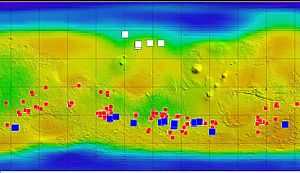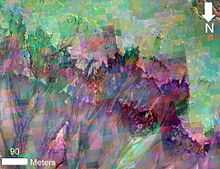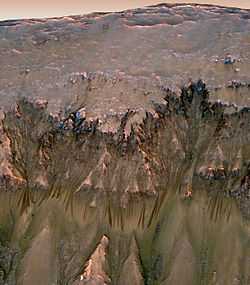Seasonal flows on warm Martian slopes

Observations from NASA's Mars Reconnaissance Orbiter have revealed what is possibly flowing water during the warmest months on Mars.[1][2][3][4] Research suggests that in the past there was liquid water flowing on the surface,[5][6] creating large areas similar to Earth's oceans.[7][8][9][10] However, the question remains as to where the water has gone.[11] In a statement released by NASA on August 4, 2011, repeat images from the Mars Reconnaissance Orbiter High Resolution Imaging Science Experiment show Recurring slope lineae (RSL), which are narrow (0.5 to 5 meters) and exhibit relatively dark markings on steep (25° to 40°) slopes, to appear and incrementally grow during warm seasons and fade in cold seasons.[1] They extend down slope from bedrock outcrops, often associated with small channels. RSL appear and lengthen in the late southern spring and summer from 48°S to 32°S latitudes that favor equator-facing slopes, which are times and places with peak surface temperatures from −23 °C to 27 °C Liquid brine near the surface might explain this activity,[2] but the exact source of the water and the mechanism behind its motion are not understood.[12][13]
Background
The Mars Reconnaissance Orbiter (MRO) is a multipurpose spacecraft designed to conduct reconnaissance and exploration of Mars from orbit that was launched in 2006.[14] The spacecraft is managed by the Jet Propulsion Laboratory (JPL), a division of the California Institute of Technology in Pasadena, for NASA's Science Mission Directorate in Washington.[15] The University of Arizona's Lunar and Planetary Laboratory operates the HiRISE camera that is on board the MRO. The camera was built by Ball Aerospace & Technologies in Boulder, Colorado. Johns Hopkins University Applied Physics Laboratory in Laurel, Maryland, provided and operates the CRISM sensor.[15][16]
Features
-

Seasonal Dark Flows, "Recurring Slope Linae" (RSL), on Martian slopes (2 November 2007).[1]
-

Oblique view of warm-season flows in Newton Crater
-
.gif)
Warm Season Flows on Slope in Newton Crater (video-gif).
-
.gif)
Dark Flows in Newton Crater Extending During Summer (video-gif).
-
.gif)
Warm season flows on slope in Horowitz Crater (video-gif).
- ^ Cite error: The named reference
WRD-20140218was invoked but never defined (see the help page).
The features imaged are only about 0.5 to 5 meters (1 ft 8 in to 16 ft 5 in) wide, with lengths up to hundreds of meters.[1][3] The width is much narrower than previously reported gullies on Martian slopes. However, some of those locations display more than 1,000 individual flows. Also, although gullies are abundant on cold, pole-facing slopes, these dark flows are on warmer, equator-facing slopes. The images show that flows lengthen and darken on rocky equator-facing slopes from late spring to early fall.[3] The seasonality, latitude distribution and brightness changes suggest a volatile material is involved, but there is no direct detection of one. The settings in which the flows occur are too warm for carbon-dioxide frost, and at some sites too cold for pure water. This suggests the action of some type of brine, which has a lower freezing point. Salt deposits over much of Mars indicate that brine was abundant in Mars's past. These recent observations suggest that brine may still form near the surface today in limited times and places.[15][16]
Dark flows
When researchers checked flow-marked slopes with the orbiter's Compact Reconnaissance Imaging Spectrometer for Mars (CRISM), no spectrographic evidence of water was apparent.[1] The features may quickly dry on the surface, or could be shallow subsurface flows. Observations have also shown that the flows are not dark because of being wet.[2] A flow initiated by salty water (brine) could rearrange grains or change surface roughness in a way that darkens the appearance. How the features brighten again when temperatures drop is harder to explain.[15][16]
Hypotheses
Dark, finger-like features appear and extend down some Martian slopes during late spring through summer, fade in winter, and return during the next spring. Repeated observations have tracked the seasonal changes in these recurring features on several steep slopes in the middle latitudes of Mars's southern hemisphere.[1][14][15] Alfred McEwen, the Principal Investigator for the HiRISE sensor and lead author of the paper published in the journal Science about the flows, states that the best explanation for these observations so far is the flow of brine. Some aspects of these observations still puzzle researchers, but flows of liquid brine fit the features' characteristics better than other hypotheses. Because salinity lowers the freezing temperature of water and sites with active flows get warm enough, even in the shallow subsurface, to sustain liquid water. Less saline water would freeze at the observed temperatures. These dark features appear different from other types of features on Martian slopes. Repeated observations have shown that they extend ever farther downhill with time during the warm season.[15] The rate of growth of these features has been shown to be consistent with shallow groundwater flow downslope through a sandy substrate.[17][18]
These results are the closest scientists have come to finding evidence of liquid water on the planet's surface today.[16] Frozen water, however, has been detected near the surface in many middle to high-latitude regions. Fresh-looking gullies suggest slope movements in geologically recent times, perhaps aided by water. Purported droplets of brine also appeared on struts of the Phoenix Mars Lander in 2008.[19] If further study of the recurring dark flows supports evidence of brine, these could be the first known Martian locations with transient liquid water.[15][16]
See also
- Climate of Mars
- Evolution of water on Mars and Earth
- Extraterrestrial life
- Life on Mars
- Extraterrestrial water vapor
- Gullies on Mars
- Hydrology of Mars
- Mars Express
- Mars Global Surveyor
- Mars Ocean Hypothesis
- Presence of shallow subsurface water ice
- 2001 Mars Odyssey
- Water in the atmosphere of Mars
- Water on Mars
References
- ↑ 1.0 1.1 1.2 1.3 1.4 Mann, Adam (February 18, 2014). "Strange Dark Streaks on Mars Get More and More Mysterious". Wired (magazine). Retrieved February 18, 2014.
- ↑ 2.0 2.1 2.2 "NASA Finds Possible Signs of Flowing Water on Mars". voanews.com. Retrieved August 5, 2011.
- ↑ 3.0 3.1 3.2 "Is Mars Weeping Salty Tears?". news.sciencemag.org. Retrieved August 5, 2011.
- ↑ Webster, Guy; Brown, Dwayne (December 10, 2013). "NASA Mars Spacecraft Reveals a More Dynamic Red Planet". NASA. Retrieved December 10, 2013.
- ↑ "Flashback: Water on Mars Announced 10 Years Ago". SPACE.com. June 22, 2000. Retrieved December 19, 2010.
- ↑ "Science@NASA, The Case of the Missing Mars Water". Retrieved March 7, 2009.
- ↑ ISBN 0-312-24551-3
- ↑ "PSRD: Ancient Floodwaters and Seas on Mars". Psrd.hawaii.edu. July 16, 2003. Retrieved December 19, 2010.
- ↑ "Gamma-Ray Evidence Suggests Ancient Mars Had Oceans | SpaceRef – Your Space Reference". SpaceRef. November 17, 2008. Retrieved December 19, 2010.
- ↑ Carr, M.; Head, J. (2003). "Oceans on Mars: An assessment of the observational evidence and possible fate". Journal of Geophysical Research 108: 5042. Bibcode:2003JGRE..108.5042C. doi:10.1029/2002JE001963.
- ↑ "Water on Mars: Where is it All?". Archived from the original on December 3, 2007. Retrieved March 7, 2009.
- ↑ McEwen, Alfred.S.; Ojha, Lujendra; Dundas, Colin M. (June 17, 2011). "Seasonal Flows on Warm Martian Slopes". Science (American Association for the Advancement of Science) 333 (6043): 740–743. Bibcode:2011Sci...333..740M. doi:10.1126/science.1204816. ISSN 0036-8075. PMID 21817049. Retrieved August 5, 2011.
- ↑ "Seasonal Flows on Warm Martian Slopes". hirise.lpl.arizona.edu. Retrieved August 5, 2011.
- ↑ 14.0 14.1 "Nasa Find Potential Signs Of Flowing Water On Mars". Huffpost UK. August 4, 2011. Retrieved August 5, 2011.
- ↑ 15.0 15.1 15.2 15.3 15.4 15.5 15.6 "NASA Spacecraft Data Suggest Water Flowing on Mars". Jet Propulsion Laboratory, Pasadena, California. Retrieved March 31, 2012.
- ↑ 16.0 16.1 16.2 16.3 16.4 "NASA Spacecraft Data Suggest Water Flowing on Mars". NASA. Retrieved July 5, 2011.
- ↑ Levy, Joseph. "Hydrological characteristics of recurrent slope lineae on Mars: Evidence for liquid flow through regolith and comparisons with Antarctic terrestrial analogs." Icarus 219.1 (2012): 1-4.
- ↑ Martín-Torres, F. Javier; Zorzano, María-Paz; Valentín-Serrano, Patricia; Harri, Ari-Matti; Genzer, Maria (13 April 2015). "Transient liquid water and water activity at Gale crater on Mars". Nature Geocience. doi:10.1038/ngeo2412. Retrieved 2015-04-14.
- ↑ "Mars Lander gets lucky break as 'water drops' discovered clinging to craft's leg". Daily Mail UK. March 18, 2009. Retrieved August 6, 2011.
External links
- NASA Picture Gallery on Seasonal flows on warm Martian slopes.
